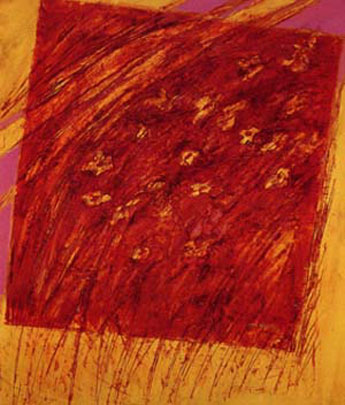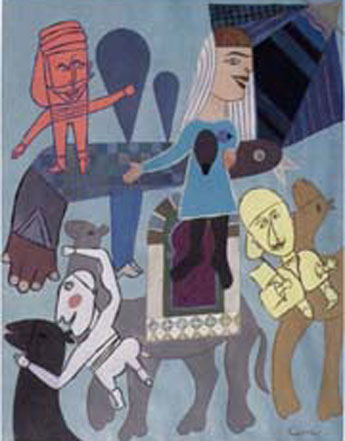A TASTE OF TUNISIAN FINE ART
TOWARDS
A CONTEMPORARY ARAB ART
During the 1970's, Arab visual artists recognized the need to join forces
in order to establish an inter-Arab domain of creation and artistic exploration
through cultural conferences and group exhibitions. Shared questions concerning
the role of the visual arts in the future of Arab culture, and the contradictions
and tensions stemming from historical circumstances, led artists to organize
activities of this kind.
Thus, in 1971 the first congress of visual arts in the Arab world, held
in Damascus, met this need for pan-Arab co-operation. A year later, in
April 1972, the Al-Wassiti Festival in Baghdad brought creative artists
from many countries face to face. The same year, at Hammamet in Tunisia,
a colloquium was held on contemporary styles in Arab visual arts. These
activities led to the first pan-Arab Biennial of visual arts in Baghdad
in 1974, followed by a second one in Rabat in 1976. These successive activities,
which brought together artists and art critics from the Middle East and
North Africa, providing them with the opportunity to exchange and confront
individual and collective experiences accumulated over the years, served
to create bonds, and to nurture the reciprocal exchange of currents and
influences, both stylistic and conceptual.
Amid the diversity of inspiration during this period, it was the sense
that Arab artists shared a common destiny which led to a real awakening
of consciousness. Since then, there has been a certain relapse, which
has not however prevented artists from getting together to participate
in a concerted way in inter-Arab activities such as the Asilah Cultural
Festival, the annual Kuwaiti exhibition of Arab artists, and the biennials
of Cairo and Sharjah, etc. TOWARDS A
CULTURAL MODERNIZATION
The development crisis faced by Arab countries today originated in the
unequal assimilation of modern products and values. The exhausted state
of many modernizing industrial projects in certain developing countries
demonstrates the limitations of strategies designed in economic terms,
with little attention paid to cultural matters. The true and comprehensive
modernization of a society must go by way of the modernization of the
culture.
However, the lure of a cultural and artistic renewal, held out so temptingly
at the onset of independence, and strongly marked by legitimate questions
concerning cultural identity (and in the seventies by collective inter-Arab
research), has been called into question by those who would seek their
identity in traditional values. The problem for the Arab world lies in
finding an appropriate response to this dilemma, and not foundering on
a stubborn rejection of "the Other." Witness the generation
of the 80's, which replaced attempts at collective effort with various
individual itineraries and the multiplication of artistic exchanges and
confrontations.
Though the infrastructures related to cultural life may be lacking, imagination
and diverse private initiatives are alive and well. Rather than attempting
a general survey of the state of contemporary Arab art, we should emphasize
its creative power and its effectiveness as a tool of social transformation.
AESTHETIC RESPONSES
It is in this general context that contemporary Arab art evolved. It would
be difficult to give an inventory of all the approaches taken up by artist
since the 1950's. Among the principal trends which seek to provide aesthetic
responses to the problems posed by the visual arts, several options can
be distinguished which co-exist and inter-relate.

FORMS OF FIGURATIVE ART
Modes of figurative representation are many and diverse. They vary according
to their terms of reference and their sources of inspiration. One tendency
draws its motifs and themes from social life. It refers, more or less
allusively, to lived reality. There are many artists, Palestinians and
others, who give prominence to scenes and types taken from social life
and historical events by means of figurative signs capable of drawing
attention simultaneously to the realities of the world and to their symbolic
representation.
THE SCHOOL OF THE SIGN
Deeply aware of calligraphy as they are, Arab painters have sought some
form of specific plastic expression by synthesizing traditional and modern
forms. This quest, which has allowed them to establish a dialogue between
the specific and the universal, delves into the primal sources of calligraphy
and the symbolic signs of popular art. Arabic calligraphy, with its aesthetic,
semantic, and philosophic - mystical dimensions, has led many painters
to make the Arabic alphabet the object of artistic exploration.
Traditional signs and symbols have also attracted the attention of several
artists who see this legacy as an important source of inspiration. In
their artistic activity, they investigate, in varying degrees, the formal
elements and the symbolic dimensions of this inheritance. Certain North
African artist, for example, mine traditional Berber art for signs which
they might use as structural elements in their works, amplifying some
and reinventing others
